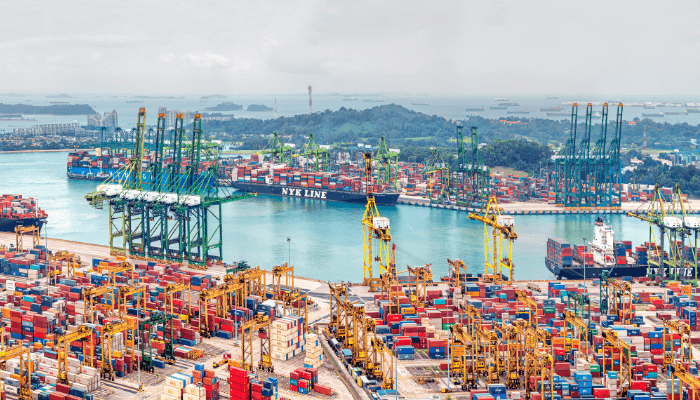
Singapore’s key exports recovered in February after a Chinese New Year (CNY)-related contraction in January, but economists warned that trade could start to feel the pain of US tariffs and their economic fallout towards the second half of 2025.
Non-oil domestic exports (Nodx) rose 7.6 per cent year on year in February, reversing a 2.1 per cent drop in the previous month, according to figures released by trade agency Enterprise Singapore (EnterpriseSG) on March 17.
The increase was less than the 8.3 per cent expansion forecast by economists in a Reuters poll.
To smoothen out the impact from CNY falling on different months, the agency noted that Nodx grew 2.3 per cent in aggregate over January and February.
On a seasonally adjusted monthly basis, Nodx increased 4.5 per cent in February, after a revised 3.3 per cent decrease in January.
Key electronics shipments rose by 6.9 per cent year on year in February, building on the 9.5 per cent rise in January. Growth was underpinned by disc media products, integrated circuits and personal computers.
DBS Bank senior economist Chua Han Teng said that global trade uncertainty could eventually hurt trade-dependent economies like Singapore, but demand for the Republic’s manufactured goods, including electronics, is expected to remain positive for the near-term.
“This is supported by a global tech upcycle and a continued expansion of new export orders in the purchasing managers’ index (PMI) for February,” he added.
Non-electronics Nodx increased by 7.8 per cent year on year in February, after a 4.8 per cent decline in January.
Non-monetary gold led the charge with a 106.9 per cent expansion, driven by safe-haven demand amid uncertainty. Measuring instruments grew 23.1 per cent, while other speciality chemicals rose by 37.5 per cent.
Unlike monetary gold exchanged among central banks worldwide, non-monetary gold refers to all other types of gold in circulation. It can take the form of coins, ingots, bars or powder. Gold is also used as an industrial metal, and as a coating or thin bonding wires for most types of semiconductor chips.
Nodx to the US, Taiwan and the European Union grew, though shipments to China, Hong Kong and Indonesia declined.
Shipments to the US rose by 21.5 per cent in February from a year earlier, following the 27.8 per cent increase in the month before, owing to non-monetary gold, food preparations and medical apparatus.
Mr Song Seng Wun, economic adviser at CGS International, said that the front-loading of orders may continue to support Singapore’s year-on-year export growth to the US in the first half of 2025.
“But US President Donald Trump’s back-and-forth tariffs-driven policy may trigger a recession in the US, leading to a sharp slowdown in Singapore’s export performance from the second half of 2025 and into 2026, as the US remains an important market for Singapore,” he added.
Shipments to Taiwan surged 77.9 per cent year on year in February, extending a 48.3 per cent expansion in January. Growth was underpinned by specialised machinery, measuring instruments and other speciality chemicals.
Nodx to the EU grew 16.7 per cent in February, after a 7.3 per cent contraction in the month earlier, owing to pharmaceuticals, measuring instruments and cocoa.
The main drag on Nodx was China, which saw a 27.4 per cent drop in shipments versus a 48.5 per cent plunge in January.
Maybank Research senior economist Chua Hak Bin said export growth is likely to slow in the coming months and could turn negative in the second half of 2025 as Mr Trump’s aggressive trade policy unfolds.
He noted Singapore faces the risk of reciprocal tariffs despite a free trade agreement with the US, a bilateral trade deficit, and low tariffs on US imports.
These tariffs may take into account Singapore’s 9 per cent value-added tax, in addition to import tariffs on US goods, which are below 1 per cent.
“Still, reciprocal tariffs on other countries will likely be much higher than Singapore, given their relatively higher import tariffs, value-added taxes and non-tariff barriers,” said Dr Chua.
Compared with a year earlier, total trade rose by 4.6 per cent in February, following a revised 6.6 per cent expansion in January.
EnterpriseSG said in February that Nodx is expected to rise by 1 per cent to 3 per cent in 2025, after eking out 0.2 per cent growth in 2024. But the agency warned of downside risks to its forecast amid “significant uncertainties” from trade frictions among major economies.
Source: The Straits Times
Share: